The Lion, the Witch and the Wardrobe is a fantasy novel for children by C. S. Lewis, published by Geoffrey Bles in 1950. It is the first published and best known of seven novels in The Chronicles of Narnia (1950–1956). Among all the author's books, it is also the most widely held in libraries. Although it was originally the first of The Chronicles of Narnia, it is volume two in recent editions that are sequenced by the stories' chronology. Like the other Chronicles, it was illustrated by Pauline Baynes, and her work has been retained in many later editions.

Most of the novel is set in Narnia, a land of talking animals and mythical creatures that is ruled by the evil White Witch. In the frame story, four English children are relocated to a large, old country house following a wartime evacuation. The youngest, Lucy , visits Narnia three times via the magic of a wardrobe in a spare room. Lucy's three siblings are with her on her third visit to Narnia. In Narnia, the siblings seem fit to fulfill an old prophecy and find themselves adventuring to save Narnia and their own lives. The lion Aslan gives his life to save one of the children; he later rises from the dead, vanquishes the White Witch, and crowns the children Kings and Queens of Narnia.
Lewis wrote the book for (and dedicated it to) his goddaughter, Lucy Barfield . She was the daughter of Owen Barfield, Lewis's friend, teacher, adviser, and trustee. In 2003, The Lion, the Witch and the Wardrobe was ranked ninth on the BBC’s The Big Read poll. Time magazine included the novel in its list of the 100 Best Young-Adult Books of All Time.
Plot summary
Peter, Susan, Edmund, and Lucy Pevensie are evacuated from London during the Blitz and sent to live with an old professor (identified in a later book as Digory Kirke) in the English countryside. While exploring the professor's house, Lucy enters a wardrobe that leads her into a snowy wooded area with a lighted lamppost growing from the ground. Lucy meets Tumnus, a faun who befriends her and informs her that she is in the land of Narnia. Tumnus intends to send Lucy to the White Witch, a ruler who keeps Narnia frozen in a perpetual winter and who requires that any human found in Narnia be sent to her. Tumnus repents, however, and escorts Lucy back to the lamppost; once there, she returns to her own world by re-entering the wardrobe and finds that only a few seconds have passed there during her absence. None of her siblings believe her story about Narnia; upon inspection, the back of the wardrobe appears solid and leads nowhere.
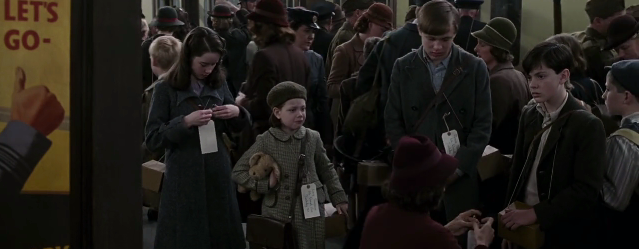
Lucy enters the wardrobe again, and it again leads her into Narnia. This time, Edmund follows Lucy and also enters Narnia. Upon arriving in Narnia, Edmund encounters the White Witch. When the Witch learns that Edmund is human and has siblings, she plies him with sweet Turkish Delight. The Witch promises to reward Edmund with more Turkish Delight if he brings his brother and sisters to her house. Upon returning to his own world, Edmund turns against Lucy and denies that he has been to Narnia. Peter and Susan chew him out and go to see the professor, who tells them that Lucy might not have been lying and he knows for a fact that she isn't crazy.
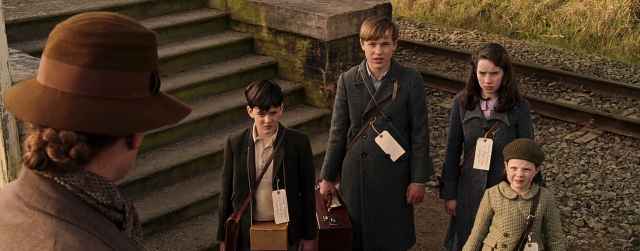
Soon afterwards, all four children enter Narnia together while hiding in the wardrobe from the housekeeper, Mrs. Macready, who was giving a tour of the house. Lucy leads the group to Tumnus's home, only to find that it has been ransacked and that the faun has been arrested. The children are befriended by Mr. Beaver, a talking animal who takes them to his home. He informs the Pevensies that because of the Witch, it is always winter and never Christmas in Narnia. He and his wife tell the children about a prophecy that the Witch's tyranny will end when "two Sons of Adam and two Daughters of Eve" sit on the four thrones of Cair Paravel, and that Narnia's true ruler – the great lion Aslan – is returning from a long absence.
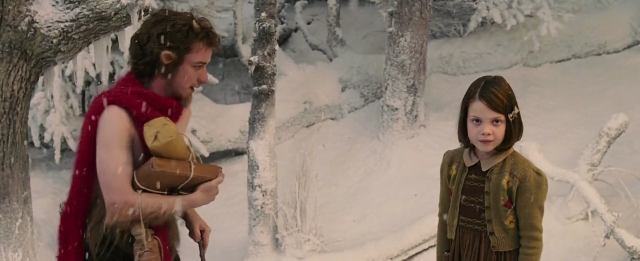
Edmund slips away to the Witch's castle. In the courtyard, he is surprised by the many statues of Narnians the Witch has turned to stone. The Witch greets him coldly, as he has come alone and with news that Aslan – her enemy – is returning. She takes Edmund prisoner and leaves her house to find and capture the other Pevensie children. Meanwhile, the Beavers – correctly surmising that Edmund has betrayed them – take the other children to meet Aslan at the Stone Table. As they travel, they find that the Witch's winter is giving way to spring. They are greeted by Father Christmas, who had been kept out of Narnia by the Witch's magic. The group arrive at their destination as winter ends and are greeted by Aslan. The Witch's enforcer, the wolf Maugrim, approaches the camp and attacks Susan, but is killed by Peter. Aslan sends a rescue party for Edmund; it arrives just in time to save him from the Witch, who had decided to kill him. The Witch parleys with Aslan, invoking the "Deep Magic from the Dawn of Time" which gives her the right to kill Edmund for his treason. Aslan denies her claim, but secretly trades his life for Edmund's.
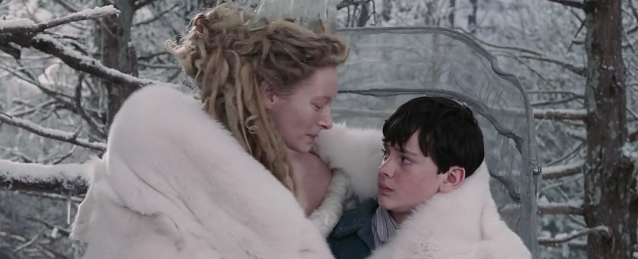
That evening, Susan and Lucy accompany Aslan to the Stone Table. They watch from a distance as the Witch puts Aslan to death. After the Witch and her followers depart to prepare for battle against Aslan's followers, Susan and Lucy remain with Aslan's body. In the morning, the girls find the Stone Table broken and Aslan restored to life. Aslan explains that the "Deeper Magic from before the Dawn of Time" has the power to reverse death if a willing victim takes the place of a traitor. Aslan takes the girls to the Witch's house and revives the Narnians that the Witch had turned to stone, including Tumnus and a giant named Rumblebuffin. They join the Narnian forces battling the Witch's army. The Narnian army prevails, and Aslan kills the Witch. The Pevensie children are then crowned kings and queens of Narnia at Cair Paravel.
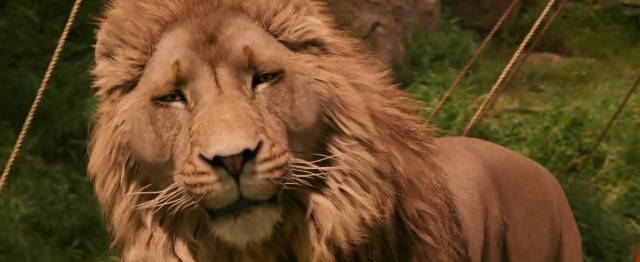
After a long and happy reign, the adult Pevensies go on a hunt for the White Stag who is said to grant the wishes of those who catch it. The four arrive at the lamppost and, having forgotten about it, unintentionally return through the wardrobe when they were looking for new adventures. When they return to England, they are children again, with no time having passed since their departure. They tell the story to the professor, who believes them and reassures
The children that they will return to Narnia one day when they least expect it.
Main characters
Lucy
Lucy is the youngest of four siblings. In some respects, she is the primary protagonist of the story. She is the first to discover the land of Narnia, which she enters inadvertently when she steps into a wardrobe while exploring the Professor's house. When Lucy tells her three siblings about Narnia, they do not believe her: Peter and Susan think she is just playing a game, while Edmund persistently ridicules her. In Narnia, she is crowned Queen Lucy the Valiant.
Edmund
Edmund is the second-youngest of four siblings. He has a bad relationship with his brother and sisters. Edmund is known to be a liar, and often harasses Lucy. Lured by the White Witch's promise of power and an unlimited supply of magical treats, Edmund betrays his siblings. He later repents and helps defeat the White Witch. He is eventually crowned King Edmund the Just.
Susan
Susan is the second-oldest sibling. She does not believe in Narnia until she actually goes there. She and Lucy accompany Aslan on the journey to the Stone Table, where he allows the Witch to take his life in place of Edmund's. Tending to Aslan's carcass, she removes a muzzle from him to restore his dignity and oversees a horde of mice who gnaw away his bonds. She then shares the joy of his resurrection and the endeavor to bring reinforcements to a critical battle. Susan is crowned Queen Susan the Gentle.
Peter
Peter is the eldest sibling. He judiciously settles disputes between his younger brother and sisters, often rebuking Edmund for his attitude. Peter also disbelieves Lucy's stories about Narnia until he sees it for himself. He is hailed as a hero for the slaying of Maugrim and for his command in the battle to overthrow the White Witch. He is crowned High King of Narnia and dubbed King Peter the Magnificent.
Aslan
Aslan a lion, is the rightful King of Narnia and other magic countries. He sacrifices himself to save Edmund, but is resurrected in time to aid the denizens of Narnia and the Pevensie children against the White Witch and her minions. As the "son of the Emperor beyond the sea" (an allusion to God the Father), Aslan is the all-powerful creator of Narnia. Lewis revealed that he wrote Aslan as a portrait, although not an allegorical portrait, of Christ.[7]
White Witch
The White Witch is the land's self-proclaimed queen and the primary antagonist of the story. Her spell on Narnia has made winter persist for a hundred years with no end in sight. When provoked, she turns creatures to stone with her wand. She fears the fulfillment of a prophecy that "two sons of Adam and two daughters of Eve" (meaning two male humans and two female humans) will supplant her. She is usually referred to as " the White Witch", or just " the Witch". Her actual name, "Jadis," appears once in the notice left on Tumnus's door after his arrest. Lewis later wrote a prequel to include her back story and account for her presence in the Narnian world.
Professor
The Professor is a kindly old gentleman who takes the children in when they are evacuated from London. He is the first to believe that Lucy did indeed visit a land called Narnia. He tries to convince the others logically that she did not make it up. After the children return from Narnia, he assures them that they will return one day. The book hints that he knows more of Narnia than he lets on (hints expanded upon in later books of the series).
Tumnus
Tumnus a faun, is the first individual Lucy (who calls him "Mr. Tumnus") meets in Narnia. Tumnus befriends Lucy, despite the White Witch's standing order to turn in any human he finds. He initially plans to obey the order but, after getting to like Lucy, he cannot bear to alert the Witch's forces. He instead escorts her back towards the safety of her own country. His good deed is later given away to the Witch by Edmund. The witch orders Tumnus arrested and turns him to stone, but he is later restored to life by Aslan.
Mr. and Mrs. Beaver
Two beavers, are friends of Tumnus. They play host to Peter, Susan, and Lucy and lead them to Aslan.
Writing
Lewis described the origin of The Lion, the Witch and the Wardrobe in an essay titled "It All Began with a Picture":
The Lion all began with a picture of a Faun carrying an umbrella and parcels in a snowy wood. This picture had been in my mind since I was about sixteen. Then one day, when I was about forty, I said to myself: 'Let's try to make a story about it.'
Shortly before the Second World War many children were evacuated from London to the English countryside to escape bomber attacks on London by Nazi Germany. On 2 September 1939 three school girls, Margaret, Mary and Katherine, came to live at The Kilns in Risinghurst, Lewis's home three miles east of Oxford city centre. Lewis later suggested that the experience gave him a new appreciation of children and in late September he began a children's story on an odd sheet that has survived as part of another manuscript:
This book is about four children whose names were Ann, Martin, Rose and Peter. But it is most about Peter who was the youngest. They all had to go away from London suddenly because of Air Raids, and because Father, who was in the Army, had gone off to the War and Mother was doing some kind of war work. They were sent to stay with a kind of relation of Mother's who was a very old professor who lived all by himself in the country.
How much more of the story Lewis then wrote is uncertain. Roger Lancelyn Green thinks that he might even have completed it. In September 1947 Lewis wrote in a letter about stories for children: "I have tried one myself but it was, by the unanimous verdict of my friends, so bad that I destroyed it."
The plot element of entering a new world through the back of a wardrobe had certainly entered Lewis's mind by 1946, when he used it to describe his first encounter with really good poetry:
I did not in the least feel that I was getting in more quantity or better quality a pleasure I had already known. It was more as if a cupboard which one had hitherto valued as a place for hanging coats proved one day, when you opened the door, to lead to the garden of the Hesperides ...
In August 1948, during a visit by an American writer, Chad Walsh, Lewis talked vaguely about completing a children's book he had begun "in the tradition of E. Nesbit". After this conversation not much happened until the beginning of the next year. Then everything changed. In his essay "It All Began With a Picture" Lewis continues: "At first I had very little idea how the story would go. But then suddenly Aslan came bounding into it. I think I had been having a good many dreams of lions about that time. Apart from that, I don't know where the Lion came from or why he came. But once he was there, he pulled the whole story together, and soon he pulled the six other Narnian stories in after him."
The major ideas of the book echo lines Lewis had written fourteen years earlier in his alliterative poem The Planets:
... Of wrath ended And woes mended, of winter passed And guilt forgiven, and good fortune JOVE is master; and of jocund revel, Laughter of ladies. The lion-hearted ... are Jove's children.
This resonance is a central component of the case, promoted chiefly by Oxford University scholar Michael Ward, for the seven Chronicles having been modelled upon the seven classical astrological planets, The Lion, the Witch and the Wardrobe upon Jupiter.
On 10 March 1949 Roger Lancelyn Green dined with Lewis at Magdalen College. After the meal Lewis read two chapters from his new children's story to Green. Lewis asked Green's opinion of the tale and Green said that he thought it was good. The manuscript of The Lion, the Witch and the Wardrobe was complete by the end of March 1949. Lucy Barfield received it by the end of May. When on 16 October 1950 Geoffrey Bles in London published the first edition, three new "chronicles", Prince Caspian, The Voyage of the Dawn Treader and The Horse and His Boy, had also been completed.
Illustrations
Lewis's publisher, Geoffrey Bles, allowed him to choose the illustrator for the novel and the Narnia series. Lewis chose Pauline Baynes, possibly based on J. R. R. Tolkien's recommendation. In December 1949, Bles showed Lewis the first drawings for the novel, and Lewis sent Baynes a note congratulating her, particularly on the level of detail. Lewis’s appreciation of the illustrations is evident in a letter he wrote to Baynes after The Last Battle won the Carnegie Medal for best children’s book of 1956: "is it not rather 'our' medal? I’m sure the illustrations were taken into account as well as the text".
The British edition of the novel had 43 illustrations; American editions generally had fewer. The popular United States paperback edition published by Collier between 1970 and 1994, which sold many millions, had only 17 illustrations, many of them severely cropped from the originals, giving many readers in that country a very different experience when reading the novel. All the illustrations were restored for the 1994 worldwide HarperCollins edition, although these illustrations lacked the clarity of early printings.

